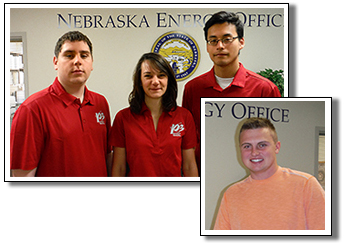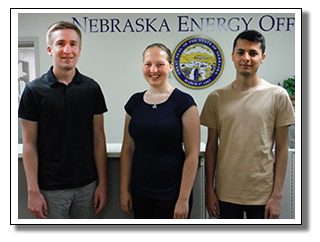Since 1992, the Nebraska Energy Office has used university student interns to accomplish a variety energy efficiency initiatives funded in part by various federal awards. In April, 1995, the Energy Office, based on its earlier experiences, published The Intern Solution — Ways to use student interns to reduce the costs of energy and environmental surveys.
In 2016, the Energy Office received a State Energy Program Competitive Award![]() through the U.S. Department of Energy
through the U.S. Department of Energy![]() to work with Nebraska local governments over a period of three years to address the energy use of wastewater facilities in municipalities with a population of 10,000 or less.
to work with Nebraska local governments over a period of three years to address the energy use of wastewater facilities in municipalities with a population of 10,000 or less.
During the summer of 2016 four student interns from the University of Nebraska-Lincoln (UNL) Partners in Pollution Prevention Program (P3 Program)![]() collected data and energy usage on more than 100 facilities and completed preliminary assessments on more than 80 of those facilities. Of those facilities, 33 of them had an actual energy intensity that was at least 15 percent higher than predicted by the P3 Program models, suggesting there would be ways to improve efficiency.
collected data and energy usage on more than 100 facilities and completed preliminary assessments on more than 80 of those facilities. Of those facilities, 33 of them had an actual energy intensity that was at least 15 percent higher than predicted by the P3 Program models, suggesting there would be ways to improve efficiency.
Last summer, 2017, five student interns from the P3 Program surveyed 15 of the 33 facilities and authored comprehensive energy studies with the technical support of the P3 Program professional staff covering the operation of the facilities surveyed.
This summer, 2018, four student interns from the P3 Program will survey 12 of the remaining 18 facilities. A Comprehensive Energy Study detailing recommended efficiency improvements will be delivered to each of the municipalities at the end of the summer. Each community then has the opportunity to decide if they wish to undertake the efficiency improvements. The efficiency projects could be financed by low-cost loans through the Energy Office’s Dollar and Energy Saving Loan Program or some other financing option available to the municipality.
The twelve facilities being studied this summer, 2018, are in Friend, Stanton, Randolph, Hartington, O’Neil, Western, Superior, Waco, Fairbury, Genoa, Pawnee City, and Springfield.
 University of Nebraska-Lincoln 2018 student interns conducting efficiency assessments on Nebraska wastewater facilities are: (Top L - Lower R) Ryan Stutzman from Lincoln, NE, a senior in Biological Systems Engineering; Lauren Klaasmeyer from Burr, NE, a senior in Chemical Engineering; Andrew Pham from Lincoln, NE, a senior in Civil Engineering and; Drake Harrington from Glenwood, Iowa, a Junior in Construction Engineering.
University of Nebraska-Lincoln 2018 student interns conducting efficiency assessments on Nebraska wastewater facilities are: (Top L - Lower R) Ryan Stutzman from Lincoln, NE, a senior in Biological Systems Engineering; Lauren Klaasmeyer from Burr, NE, a senior in Chemical Engineering; Andrew Pham from Lincoln, NE, a senior in Civil Engineering and; Drake Harrington from Glenwood, Iowa, a Junior in Construction Engineering.
In addition to the wastewater project, the Energy Office received a State Energy Program Competitive Award in 2017 through the U.S. Department of Energy for the Nebraska Initiative — Benchmarking and Beyond project. The goals of this three year project are to:
- Have all Nebraska state government buildings benchmarked and benchmark any buildings of local governments who voluntarily participate;
- Develop a state building benchmarking policy;
- Provide technical training for government building operators and;
- Provide building energy use data collection and benchmarking training for university student interns on the state level as well as Nebraska Green Schools
 high school Science, Technology, Engineering and Math (STEM)
high school Science, Technology, Engineering and Math (STEM) teachers and their students in local communities.
teachers and their students in local communities.
In May of 2018, the Project Director from the University of Nebraska-Omaha (UNO) College of Business Administration, Nebraska Business Development Center![]() trained student interns to collect, assess and enter basic benchmarking data for state and local government buildings in ENERGY STAR® Portfolio Manager
trained student interns to collect, assess and enter basic benchmarking data for state and local government buildings in ENERGY STAR® Portfolio Manager![]() and produce the ENERGY STAR reports. The three student interns trained on Portfolio Manager for the summer of 2018 are students from UNL’s College of Architecture.
and produce the ENERGY STAR reports. The three student interns trained on Portfolio Manager for the summer of 2018 are students from UNL’s College of Architecture.![]()
The Nebraska Department of Administrative Services, Building Services Division provided the Energy Office with building size information and utility reports on 3,815 state-owned buildings. Student interns began entering state building energy usage into a computer program called ENERGY STAR® Portfolio Manager. The interns have been reviewing the information from the Portfolio Manager and the utility reports.
Each student intern works with an Energy Office staff member who is part of the Nebraska Initiative Benchmarking and Beyond team. The student interns will be assisting in the verification process of the data by the state agencies involved in the benchmarking process.
Once the process is complete, the student-interns will enter utility data into the ENERGY STAR® Portfolio Manager program and generate reports. These reports will provide baseline data on the energy use in similarly-sized state buildings. The reports will then be provided to state agencies and to a Benchmarking leadership representative within state government. The state agencies and leadership representative will review the data and consider future benchmarking policy recommendations for state government buildings. A Competitive Award to support the Benchmarking and Beyond project was provided by the US Department of Energy, State Energy Program.
 The student interns working on government building benchmarking and data collection are: (L-R) Trevor Kirschenmann from Omaha, NE, a senior in Architecture; Kristina Harms from Rochester, MN, a junior in Architecture; and Adrian Silva from Gering, NE, a senior in Architecture.
The student interns working on government building benchmarking and data collection are: (L-R) Trevor Kirschenmann from Omaha, NE, a senior in Architecture; Kristina Harms from Rochester, MN, a junior in Architecture; and Adrian Silva from Gering, NE, a senior in Architecture.